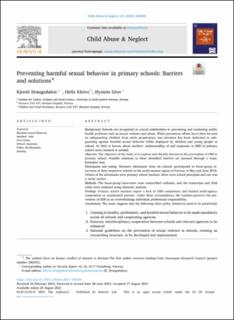Preventing harmful sexual behavior in primary schools: Barriers and solutions
Peer reviewed, Journal article
Published version
Permanent lenke
https://hdl.handle.net/11250/2988058Utgivelsesdato
2021Metadata
Vis full innførselSamlinger
Originalversjon
Draugedalen, K., Kleive, H. & Grov, Ø. (2021). Preventing harmful sexual behavior in primary schools: Barriers and solutions. Child Abuse & Neglect, 121, Artikkel 105295. https://doi.org/10.1016/j.chiabu.2021.105295Sammendrag
Background: Schools are recognized as crucial stakeholders in preventing and combating public health problems such as sexual violence and abuse. While prevention efforts have often focused on safeguarding children from adult perpetrators, less attention has been dedicated to safeguarding against harmful sexual behavior (HSB) displayed by children and young people at school. As little is known about teachers' understanding of and responses to HSB in primary school more research is needed.
Objective: The objective of the study is to explore and identify barriers to the prevention of HSB in primary school. Possible solutions to these identified barriers are pursued through a transformative lens.
Participants and setting: Nineteen informants from six schools participated in focus-group interviews at their respective schools in the south-eastern region of Norway in May and June 2019. Fifteen of the informants were primary school teachers, three were school principals and one was a social worker.
Methods: The focus-group interviews were transcribed verbatim, and the transcripts and field notes were analyzed using thematic analysis.
Findings: Primary school teachers report a lack of HSB competence and limited multi-agency cooperation or coordinated practice. Under these circumstances, the teachers perceive the prevention of HSB as an overwhelming individual professional responsibility.
Conclusions: The study suggests that the following three policy initiatives need to be prioritized:
1. Training in healthy, problematic, and harmful sexual behavior to be made mandatory across all schools and cooperating agencies.
2. Statutory interdisciplinary cooperation between schools and relevant agencies to be enhanced.
3. National guidelines on the prevention of sexual violence in schools, creating an overarching structure, to be developed and implemented.

